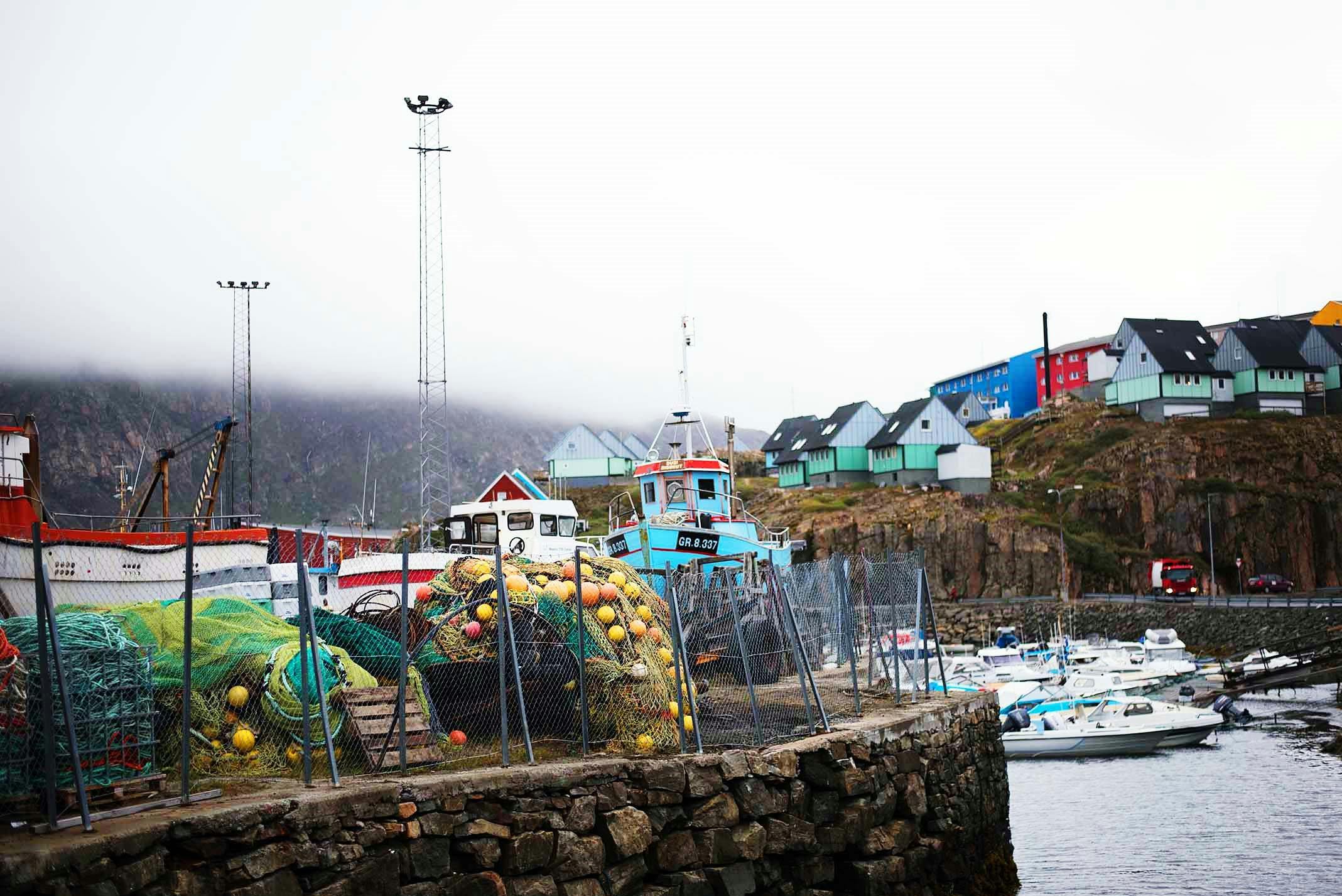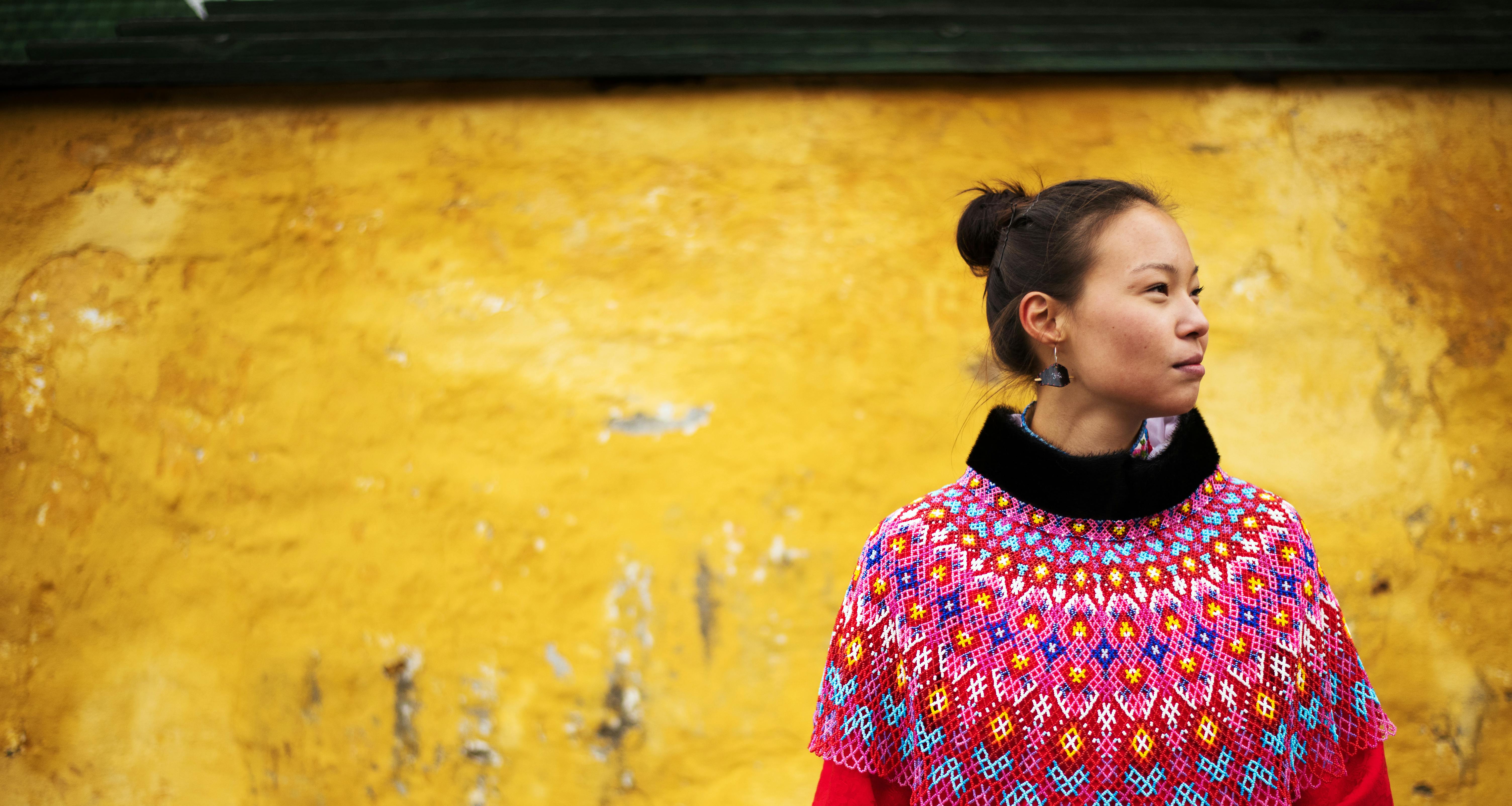Berda Larsen’s Greenland: Stunning Nature and Timeless Tradition
Berda Larsen takes great pride in donning her traditional Greenlandic attire. It’s a vibrantly colorful outfit, customarily worn only on special occasions like weddings, baptisms and holidays. Larsen’s traditional dress is distinctive to western Greenland culture and traditions — she was born and raised in the town of Sisimiut, just above the Arctic Circle on the country’s west coast — and it’s made more unique by embellishments from various family members.
“My grandmother designed the pattern of the pearl beadings,” she says of the dazzling, multi-hued craftwork, “so most of my female family members have the same pattern in our beadings, with different colors.” Larsen’s own beading was created by her mother for her big sister’s confirmation 18 years ago. “It took her a year to make it,” she explains. “After that, she said, ‘No more.'”
Historically speaking, beads were a fairly late addition to the traditional Greenlandic outfit, a byproduct of interaction with Europeans after they arrived on the country’s shores in the 17th and 18th centuries. The costumes are still made the traditional way and fashioned mostly from animal skins, as they have always been.
“I will say that wearing the national clothing in summer is quite warm since it’s mostly made out of sealskin,” Larsen reveals. “My my, standing there with a lot of travelers — you need a fan, honey!”

The mountain goat starts guiding
Just 24, the vivacious Larsen has already been leading Greenland cruise excursions and charming visitors— most of whom know her as “Birdie”—for six years. She began guiding hiking tours on Palasip Qaqqaa, the 1,785-foot (544-meter) mountain that is the backdrop to Sisimiut and its bold rainbow of wooden houses. “Those visitors also called me the ‘mountain goat,’” she remembers with a bright smile.
Today, Larsen guides tours closer to sea level too, including to nearby Tele Island, where remnants of Greenland’s nomadic Thule culture are still visible; and to Assaqutaq, the site of an intact 20th-century fishing village, abandoned in the 1960s, which today serves as a summer camp for local students.

Getting to know Greenland
Greenland is the world’s largest island, but the country’s population of 56,000 is spread thinly over more than 830,000 square miles (more than 2.17 million square kilometers), an area more than three times the size of France.
“Every city, town and settlement in Greenland is very different from the other, even for a native like me,” says Larsen. In fact, she suddenly felt like a foreigner in her own country after moving south to the town of Qaqortoq at the beginning of 2017.
“I couldn’t understand what the taxi driver was saying, because the dialect is so different,” she explains. “I had to ask him politely if he could speak Danish or English in order for me to understand him.”
The cultural history of Greenland
Greenland has officially been part of Denmark (and its precursor Denmark-Norway) since the early 18th century, so schoolchildren still learn Danish as well as English. “Travelers are often surprised that we speak English so well,” says Larsen. “We Inuit [the largest ethnic group in Greenland] first learn our native language. In elementary school, we start learning Danish from second grade, and then English in third grade. But I’ll be honest and say that I actually learned more about the English language by watching the movie “Calamity Jane” with Doris Day — you know, in the good old days of VCRs.”
The 1953 movie taught her more than just language, she says. “’Calamity Jane’ gave me confidence that a woman can be not only feminine but also independent. You, yourself, make the limits of what you can be capable of,” she says. It’s a spirit she’s passing on to her young daughter, Winona, who’s just turned 3.

An inextricable bond with nature
Aside from guiding tours, Larsen is also currently studying culture, history and society at the University of Greenland, in Nuuk, the country’s capital and largest city. “I’m lucky that the education I wish for is here in Greenland,” she says. “Most in my age group choose to go to Denmark to get an education.” The government pays not just for the education itself, but also for the ticket abroad and a monthly allowance. “Most students come back to Greenland afterwards, though, to work here in our country,” she says.
Like most locals, Larsen feels a deep bond to her homeland and its environment. One could argue that most of the top Greenland attractions are found in its rugged wilderness. “People in Greenland have a good relationship with nature, ever since we were born,” she says. “When I was a kid, I remember we spent a lot of time in nature.” They spent summers fishing, hiking in the mountains, or gathering wild edibles like angelica, Labrador tea and alpine juniper. When autumn arrives, it brings the sweet Arctic blueberry and tart crowberry.
“Then winter knocks on our door, and we use dogsleds and snowmobiles,” Larsen continues. In Sisimiut and all points northward in Greenland, sleds have been the primary mode of winter transportation for centuries.
Larsen adds that the seasonal effects of climate change in Greenland are evident. “There is a big change over the years,” she says. Her mother remembers when the frozen ice that appeared along the coast in Sisimiut during the winter was not far away. “You couldn’t see where it ended with your own eyes,” Larsen explains. “When I grew up, you could still walk on the ice in the ocean. But now that my daughter is growing up, it’s less, and you really have to be careful where you step.”
Larsen hopes that her guests leave Greenland inspired, knowledgeable and excited about this extraordinary destination so they can then share with others at home. “My goal is to connect with the traveler and hopefully give more than the ordinary, and to create good memories,” Larsen says. “Because isn’t that what traveling is about?”

